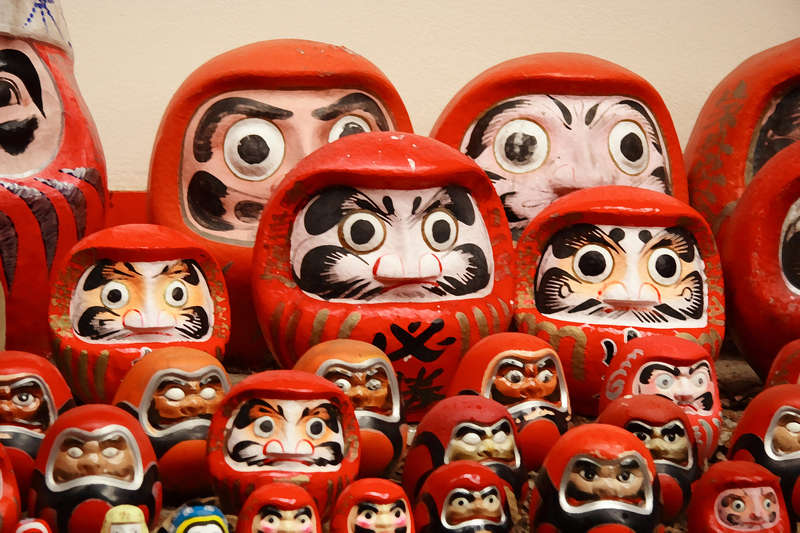Daruma (だるま) are a type of Japanese dolls modeled after the Buddhist monk Bodhidharma, known as Daruma in Japan. Bodhidhrama is considered the founder of Zen Buddhism and is well known for his method of attempting to achieve enlightenment through meditation.
Daruma dolls have a very distinctive shape and face. Daruma dolls are round, in the shape of a tumbler doll, and are often weighed down in the bottom so that even if they fall over they’ll right themselves. Because of their ability to return to their original position even when pushed over, they have become synonymous with a popular Japanese phrase “Nana korobi yaoki” (七転び八起き) which means “fall down seven times, get up eight.”
The most common Daruma doll has red robes and a white or peach face. The black eyebrows painted on the face of the Daruma are often shaped to represent cranes, which are said to live for 1,000 years, while the black mustache is supposed to represent a tortoise, said to live for 10,000 years. There are Japanese legends that explain why the doll is represented without eyelids or limbs. According to some legends, the Bodhidhrama meditated for nine years straight, during which his arms and legs are said to have withered and fallen off. It’s also told that once, the Bodhidhrama fell asleep while meditating, and cast away his eyelids in anger so he would never be interrupted by sleep again; in Japan it’s often said that the eyelids fell to the ground and sprouted the first green tea leaves.
The Daruma doll is a very distinctive and well-known figure in Japan. Symbols of Daruma, including the dolls, became popular in the 16th century in an effort to ward off smallpox. The god thought to spread smallpox was said to like the color red, so people wishing to prevent smallpox from entering their home or taking a life would decorate the inside and outside of their home with red in hopes to gain favor with the god. As the image of Daruma was often depicted as wearing entirely red robes, the Daruma dolls were sold as talismans to ward off smallpox.
While smallpox disappeared in the Meiji period of Japan, the dolls remained popular as good luck charms. After the use of Daruma dolls as good luck charms began to rise in popularity, they were sold without pupils painted onto their eyes; people would make a wish after they bought the doll and fill in one eye and, if their wish came true, they would fill in the other. This is a practice that still prevails today; it’s very easy to see a bright red Daruma doll with one eye drawn in anywhere around Japan, from a hospital waiting room to a large company to a personal home.
Filling in the eyes of a Daruma doll isn’t something as easy as buying a doll and coming home and immediately filling in the eyes to complete the doll’s face. Daruma dolls can be bought at many important times in a person’s life in order to bring good luck, but there are also some common times to buy a Daruma doll, too, such as before a wedding or around the start of the New Year. After buying the doll, the first step is to make a wish and paint or draw in a black circle in the left eye. The doll is then left on a shrine or somewhere where it can easily be seen, so the owner can be reminded of their goal every time they catch sight of the doll. When the wish has been fulfilled, the right eye can be filled in as thanks. The act of finishing the second eye is often called “Me ga deru” (目が出る), which means “eyes have appeared.”
When the year ends, it’s common for people to bring their finished Daruma dolls to a local temple for a ceremony called Daruma Kyuou (達磨供養), which is the customary burning of Daruma doll. At these events, most people will purchase a new Daruma doll for their goals in the New Year.
You can buy your own Daruma doll to help you with your New Year goal at Asahi. Our Daruma dolls come in multiple sizes and are sure to watch over you as you strive to fulfill your goal in 2014!


0 Comments
Leave a Comment